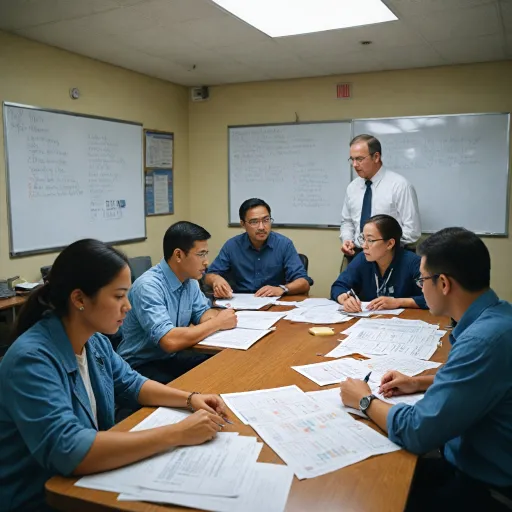
Understanding Employee Engagement
Fostering a Strong Connection Between Employees and Work
Understanding the depth of employee engagement is pivotal in recognizing when talent requires fresh challenges. Employee engagement refers to the extent to which employees are deeply involved in, enthusiastic about, and committed to their work and organization. This engagement is not just a metric but a core driver of an organization's success. When employees are highly engaged, their job performance and job satisfaction tend to improve significantly, leading to better outcomes for the organization. Several components shape employee engagement, including overall job satisfaction, the work environment, and the alignment of tasks with employees' skill sets and characteristics. Organizations aiming to enhance engagement should pay close attention to these aspects. For instance, if the characteristics of a job do not align well with an employee's skills, their engagement and performance might dip, signaling the need for new job challenges or developing new job roles. An organization's culture and its approach to feedback can further influence employment engagement levels. High levels of engagement are often visible where company culture encourages open communication and respects employees’ needs and job performance feedback. Thus, it's crucial for HR professionals to understand these dynamics to enhance employee satisfaction and capacity planning for long-term success. Properly understanding these aspects not only aids in current job descriptions and tasks responsibilities but also prepares the organization for future work changes. With an increasingly dynamic work environment, identifying talent needs efficiently is even more critical. Resources like strategic succession planning provide insights into aligning hiring strategies with long-term objectives, ensuring the right talent is nurtured in the right roles (strategic succession planning). As we delve into the remaining sections, we will explore how AI can play a transformative role in identifying and addressing these needs, enabling HR departments to refine their approach and drive impactful outcomes for the organization.The Role of AI in Identifying Talent Needs
AI's Transformative Role in Talent Management
In today's dynamic work environment, understanding when an employee needs new challenges is crucial for maintaining high job satisfaction and performance. Artificial intelligence (AI) is playing an increasingly significant role in identifying these needs, offering insights that were previously difficult to obtain. By analyzing various data points, AI can help organizations recognize when their top talent requires new tasks to stay engaged and motivated.
Analyzing Job Performance and Feedback
AI systems can process vast amounts of data related to job performance and feedback, allowing HR professionals to identify patterns that indicate an employee's readiness for new responsibilities. These systems evaluate characteristics such as skill sets, task completion rates, and feedback from peers and supervisors. By doing so, AI helps in developing job roles that align with an employee's evolving skills and aspirations.
Enhancing Employee Engagement Through AI
Employee engagement is a critical factor in job satisfaction and overall organizational success. AI tools can assess engagement levels by analyzing employee interactions, feedback, and performance metrics. This analysis helps in identifying employees who might benefit from new challenges, thereby enhancing their engagement and satisfaction. By proactively addressing these needs, organizations can foster a more dynamic and motivated workforce.
AI-Driven Capacity Planning
Capacity planning is another area where AI can significantly contribute. By predicting future work trends and skill requirements, AI assists HR departments in aligning their hiring and development strategies with long-term organizational goals. This ensures that employees are not only meeting current job descriptions but are also prepared for future tasks and responsibilities.
For those interested in exploring opportunities in entry-level HR positions with AI integration, this resource offers valuable insights into how AI is shaping the future of HR roles.
Key Indicators of Talent Needing New Tasks
Identifying Key Signs of Talent Desiring New Challenges
In today's dynamic work environment, organizations are continuously striving to maintain a high level of employee engagement and job satisfaction. Recognizing when talented employees are ready for new challenges is crucial for sustaining their motivation and job performance. One effective way to identify employees who may need new tasks is through regular feedback and performance reviews. Constructive feedback not only helps in understanding an employee's current task performance but also reveals insights about their aspirations and long-term career goals. Pay close attention to the feedback loop; when employees consistently express interest in skill development or display eagerness to diversify their skill set, it's a clear sign that they might be under-challenged in their current role. Observing job satisfaction levels can also offer significant clues. Declining enthusiasm or decreased engagement in current tasks may suggest that a high-performing employee's needs are not being fully met. Regular surveys or informal check-ins can help organizations assess employee satisfaction and identify potential areas for improvement. Another indicator is the capacity planning of the workforce. Employees who consistently exceed performance expectations could benefit from challenging tasks or new responsibilities aligned with their strengths. Not only does this contribute to personal growth, but empowers them to actively shape the future work environment. Organizations should also analyze job performance metrics to identify patterns or characteristics that may signify readiness for new challenges. These can include:- Decreased interest in routine tasks or repetitive responsibilities.
- Expression of interest in developing new skills or exploring different job descriptions.
- Increased occurrence of feedback mentioning lack of challenges or new task opportunities.
- High potential demonstrated in past projects, indicating readiness for more complex roles.
Implementing AI Solutions in HR
Integrating AI Solutions into HR Practices
Incorporating AI into human resources can significantly enhance how organizations identify and address the evolving needs of their talent. By leveraging AI, companies can streamline processes, improve job satisfaction, and ultimately boost employee engagement.
AI solutions can help HR teams in several ways:
- Personalized Feedback: AI systems can analyze employee performance data to provide tailored feedback, helping employees understand their strengths and areas for improvement. This personalized approach can lead to higher job satisfaction and better job performance.
- Task Allocation: By examining skill sets and job characteristics, AI can suggest new tasks or responsibilities that align with an employee's capabilities and career aspirations. This ensures that top talent remains challenged and engaged.
- Capacity Planning: AI tools can assist in long-term capacity planning by predicting future work needs and identifying skill gaps within the organization. This proactive approach supports strategic hiring and skill development.
- Employee Satisfaction Monitoring: AI can continuously monitor employee satisfaction levels by analyzing feedback and engagement metrics. This allows HR to address issues promptly, maintaining a positive work environment.
Implementing AI in HR requires careful consideration of company culture and privacy policies. Organizations must ensure that AI solutions align with their values and respect employee privacy. By doing so, they can foster a supportive environment where employees feel valued and motivated.
Case Studies of Successful AI Integration
Real World Impacts of AI-Driven HR Solutions
Artificial intelligence (AI) has taken significant strides in reshaping how organizations approach human resources. Successful integration of AI solutions is driving organizations toward improved employee engagement, job performance, and job satisfaction by recognizing the precise needs of talent. Here, we delve into real-world examples highlighting the transformative power of AI.- Enhanced Job Matching: A multinational organization utilized AI to better match employee skill sets with appropriate tasks. This approach significantly increased job satisfaction and productivity, as employees engaged in work that was both challenging and fulfilling.
- Improved Feedback Mechanisms: Several companies have implemented AI systems to provide timely and constructive feedback. By analyzing performance data, AI systems now aid managers in identifying the characteristics and needs of employees, which in turn helps in developing jobs that align with personal and organizational goals.
- Optimized Employee Development: AI-driven insights are pivotal in capacity planning and anticipating future work demands. By identifying employees' aspirations and potential, organizations are able to craft tailored development plans, maintaining high levels of employee satisfaction and engagement.
- Data-Driven Recruitment: AI is effectively streamlining the hiring process by filtering through vast amounts of candidate information to identify top talent. This reduces the time and resources spent, while aligning new hires with the company culture and tasks responsibilities they excel in.
Future Trends in AI for HR
Emerging Directions in AI for Human Resources
As we look towards the future, it's clear that artificial intelligence will play an increasingly integral role within human resources. Organizations are already recognizing how AI can enhance job performance by identifying the unique skill sets and needs of top talent, helping to match employees with tasks that match their capacities. The evolving landscape of work suggests several trends that will shape how AI integrates into HR processes.- Increased Personalization: AI-driven insights will enable a personalized approach to employee development by considering individual characteristics, job satisfaction levels, and feedback. This will ensure that talent is being developed in line with both current performance and future potential.
- Enhanced Employee Engagement: By aligning tasks and responsibilities with employees' skills and job descriptions, AI will help foster a highly engaging work environment. This alignment improves both employee satisfaction and organizational outcomes.
- Advancements in Capacity Planning: Future AI solutions will better predict workforce needs, supporting strategic decision-making around hiring and long-term talent development. This will ensure that employees' capabilities are fully utilized while maintaining a thriving company culture.
- Focus on Ethical Considerations: With AI's increasing role, ethical considerations such as privacy policy compliance and bias reduction will be paramount. Organizations will be responsible for ensuring that their AI systems are transparent and fair in evaluating job performance.
- Integration of AI in Learning and Development: AI will accelerate the development of tailored learning experiences, enabling employees to upskill and adapt to new tasks more quickly. This personalized approach will be critical for meeting the future work demands.












